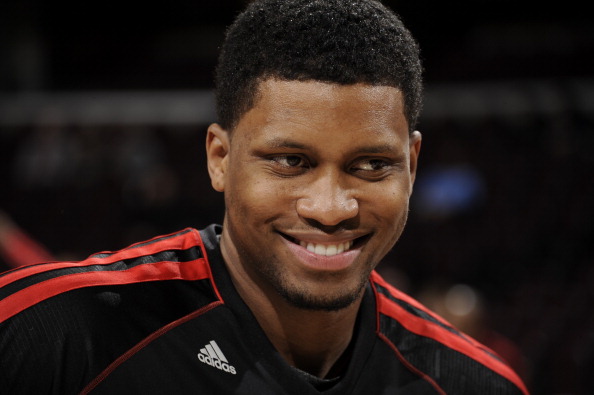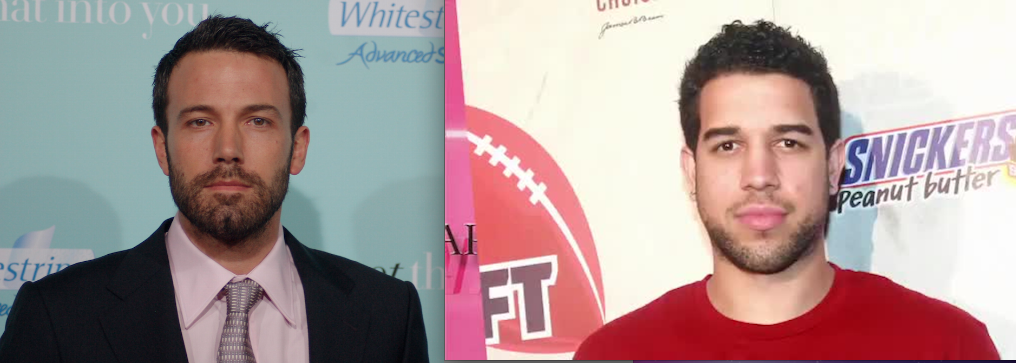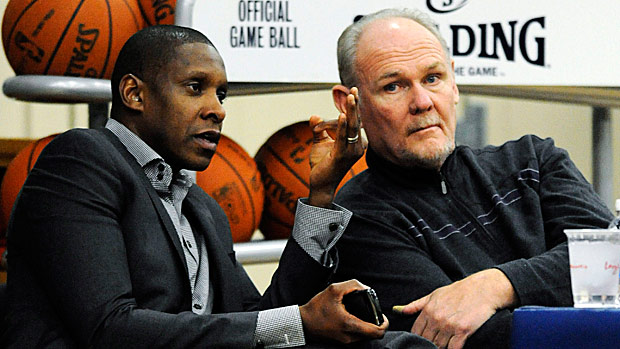How Rudy Gay could be the Key to the Raptor’s Offence after all
Many of the top offenses in the league have been winning this year playing ‘small ball.’ Miami, New York, Golden State, Houston and (though to a lesser extent) Oklahoma City have all taken a cue from the D’Antoni Suns and had success spacing the floor with small ball, four shooter lineups. You have to look long and hard through the lists of Raptors 5 man lineups to find anything more than a brief trial of small ball spacing from Dwayne Casey. Given the lack of offensive creativity from the Raptors this past season and the core group of players they have under contract (particularly Rudy Gay, Landry Fields and yes, Andrea Bargnani), going small seems like an option the Raptors ought to have explored. I would argue that it’s the best way to get the most out of a lineup that a litany of long, overpaid contracts is going to make difficult to adjust.
First off, let’s be clear. I think that the Raptors are going to spend the bulk of their time playing Amir Johnson and Jonas Valanciunas on the floor together. But Miami and Golden State both started and stuck with traditional lineups for much of the time as well. In both cases, however, their best crunch time units proved to be when they took out their second big and spread the floor with shooters. Casey paired Johnson and Valanciunas together often down the stretch with positive results, particularly on the defensive end. If Valanciunas can develop anything close to the kind of chemistry that Johnson had with the now departed Ed Davis, those two will be a lot of fun to watch. Having said that, for second quarter lineups when one of the bigs is resting, if one of those two is in foul trouble, for a change of pace or to exploit certain matchups, the Raptors should be going small with every chance they get.
Let’s look at what going small does for the Raptors piece by piece:
SPACING & THE WING PLAYERS
Whether by decision or not, the Raptors have assembled a starting 3 in Lowry-DeRozan-Gay whose games are all problematically similar. Each one of those guys likes to slash to the hoop. That’s not a problem on it’s own, but it becomes one when teams are able to crowd the paint with two bigs near the basket and two wing defenders slacking off of both Gay and DeRozan. Opposing teams are more than happy to give up 3-point looks to those two from around the arc and take away the paint instead. This is what often happened against good defenses in the months after the Gay trade. DeRozan and Gay are both shoot first, second and third mentality players when slashing to the basket. When you play that way and run in to four defenders down low, you’re going to end up short of the hoop with more turnovers than anything else. According to NBA.com stats, there wasn’t a single spot in the area surrounding the paint where Gay or DeRozan were anything remotely close to efficient shooting the ball, despite a high volume of attempts. Neither of those two are particularly good passers either, a problem that was compounded by the Raptors refusal to station a man in the corner.
The secret is long since out on the corner 3 being the best shot in basketball outside of a dunk/layup. Despite this, the Raptors starters were amongst the worst in the league in attempting corner 3s, perhaps because they didn’t start a wing player who is adept at shooting them. DeRozan and Gay don’t shoot a lot of corner 3s for a reason; they were a combined 29% from the corners in 2012-13 (pardon me for a moment). The reality is though, that those two are going to play a lot of time together, and for as long as they do, that pass to the corner is going to be wide open. Inserting someone like Terrence Ross to the lineup for either Valanciunas or Amir Johnson opens things up in two ways.
1) It pulls a big away from the basket. More than likely, it pulls two away. This is because the opposing small forward is more likely to be guarding DeRozan or Ross, with the opposing power forward on Gay, thereby pulling him out of the paint and uncomfortably towards the 3-point line as well. Suddenly a Gay, DeRozan or Lowry drive to the hoop is a desirable thing with room to work in, as all 3 players finish over 50% of their shots when they get to the rim and draw a healthy amount of fouls while doing so.
2) It presents an easy bail out pass to Ross in the corner if the defense does manage to collapse to the basket. Having shot 42% from the left side corner in his rookie season, that should be a shot that the Raps should be putting Ross in a position to take much, much more often.
Terrence Ross was brought in to the league to be a shooter. The Raps used him almost exclusively off the bench, running around screens for above the arc catch and shoots, which is not an easy shot. Having Ross plant in the left corner to create space for the slashers and spot up for easy 3s.
Casey stubbornly forced a traditional offence this past season with two bigs, Rudy Gay at the 3 and Kyle Lowry pretending to be a traditional bring the ball up the court and then pass first point guard. That set simply does not create a situation where DeRozan, Gay and especially Lowry are able to do what they do best. Those guys drive to the basket, and they actually do it very well when there is a room to do so. But they need space and shooters waiting in the corners in order to do so well.
LANDRY FIELDS
The closest the Raptors played to small ball was by using Alan Anderson, almost definitely not to be back next season, or Landry Fields. Landry Fields is problematic as a small ball 4 for several reasons. He’s not big enough to guard large power forwards, and he left his jump shot in New York, which takes away the offensive benefits of spacing the floor. Landry’s 3-point shooting career arc has been troublingly Affleckian thus far. He burst on the scene with a Good Will Hunting like 39% from deep, getting all sorts of critical acclamation and buzz. His second season 26% shooting percentage had Pearl Harbour and Reindeer Games written all over it, but he was able to continue riding out his A-list status and potential to a big paycheck this season, only to turn in a Paycheck, Jersey Girl and Gigli performance with 14% shooting from 3. Whether or not this metaphor means that Landry Fields will bounce back this season with The Town and Argo like shooting that allows him to be a valuable small ball power forward, especially off the bench, remains to be seen. If he can, he has a chance to earn his contract. He has adapted well to his inability to shoot by cutting backdoor to the basket from the corners when his man turns his back on him to help against someone else driving to the basket. That was Field’s best offensive look all season long, and it helps make up for some of the misses. But he can’t help out his teammates in spacing the floor unless he knocks down that corner 3 with consistency.
THE BIGS
Johnson and Valanciunas are both very well suited to play in this system. They’re both committed screen men in running the high-low pick and roll. Valanciunas has a lot of work to do as a lone rim protector, but it is simply a matter of time, rather than a lack of ability or understanding, until he is able to do so. Amir thrives in this role already. While Amir is a better defensive option in this lineup, the floor spacing would allow Valanciunas to get isolation opportunities working his post game down low. If the last month of the season was any indicator, Valanciunas getting the ball on the block with only one man to beat would be a welcome part to a healthier offense.
ANDREA BARGNANI?
It’s unclear whether or not Bargnani will be on the team come the fall. But, what comes at contrast with the eye test for anyone who watched him play and read his stat lines this past season, Bargnani was actually highly effective as a ‘stretch 4’ this past season. Well, at least his presence was highly effective for his teammates, I should say. The only small ball type lineups that Casey actually employed with anything close to regularity this past season was when he would play Bargnani at the 4. It seems like a contradiction of terms to say that playing a 7-footer at the power forward is going small, but the reality of how he plays on both ends of the court is that it is. He doesn’t protect the rim, rebound well or contain opposing bigs with his height and reach. On offence, he has no post game and lives along the 3 point line. Hate dislike this style of play from him as we all may, the surprising reality is that the two lineups where Bargnani played the most amount of minutes, both of which featuring Valanciunas playing centre, both outscored their opponents and resulted in an above average 3-point % for the team. His numbers were not fantastic in that time, but the space that he created proved effective for his teammates in a reasonably large 128-minute sample size. Whether or not this means that we have reason for calmed antagonism towards Bargnani this coming season, or that Ujiri will actually have a sales-pitch with which to trade him, who knows. But his presence does show what floor spacing can accomplish with these players.
RUDY GAY
Rudy Gay is the centerpiece of any small ball lineup. His defensive versatility and length enable him to guard anyone outside of a 7-footer. When he can get to the rim he is an efficient scorer, it’s just all of the shooting decisions that he makes if he can’t quite get there that leave you scratching your head or throwing your remote. Most importantly, he recently underwent corrective laser surgery for his vision after playing the last few seasons with continually worsening vision that he refused to wear contacts or goggles for.
The outrage/curiousity/humour/complete incomprehension that I, and really anyone should have about that last fact could easily fill an entire column, so I’ll keep a lid on that for now. How it isn’t a bigger story, I don’t know. Consider this though, before the trade, the Grizzlies had a shooter who refused to wear goggles or contacts so that he could actually see, an al-star centre who refused to be anything close to in shape, and Tony Allen, a guard whose cement hands consistently miss layups, and who warms up by throwing around a medicine ball pre-game. Not exactly the best way to learn soft touch. And that team was still amazing! Imagine how good they could have been with a layup line, a YMCA membership and a pair of glasses.
The important thing to take away from this whole vision nonsense is that Rudy Gay can now actually see. I’m not saying that he’s going to shoot 40% from 3 on high volume shooting this season, but I have to believe that the ability to functionally see the rim can only improve his shot. If Gay can actually be a knockdown 3-point shooter, and the Raptors can space the floor around him for drives and drive and kick 3 pointers, Rudy Gay actually has the potential to go from albatross to simply overpaid. Rudy Gay’s NBA destiny makes the most sense as a small ball 4, and barring major roster changes, that seems like a route the Raptors would be fools not to experiment with.



